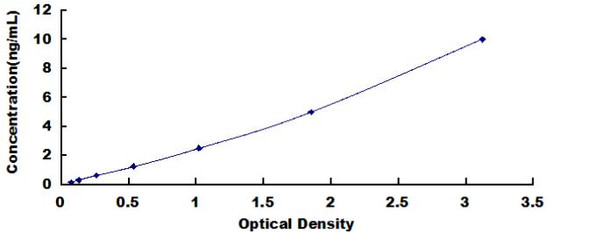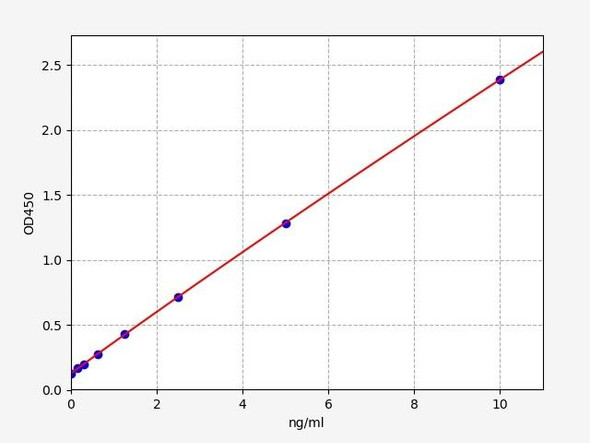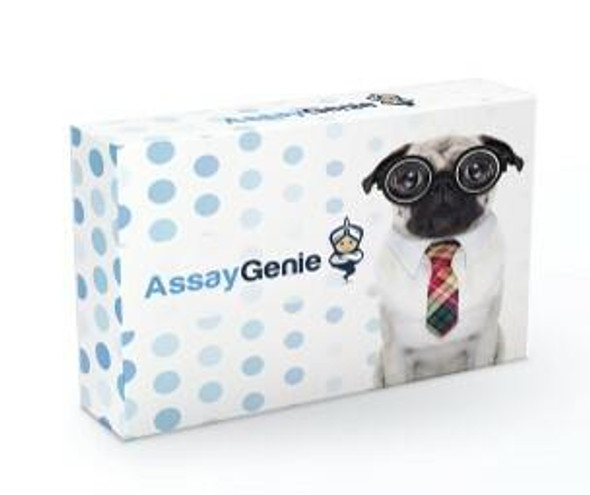Description
Human CYGB (Cytoglobin) ELISA kit
The Human CYGB (Cytoglobin) ELISA Kit is specifically designed for the precise measurement of CYGB levels in human serum, plasma, and cell culture supernatants. With exceptional sensitivity and specificity, this kit delivers accurate and consistent results, making it an invaluable tool for various research purposes.CYGB, also known as Cytoglobin, is a key protein with diverse functions, including oxygen binding and transport, antioxidant defense, and regulation of cell growth and apoptosis.
Its involvement in various physiological and pathological processes makes it a vital biomarker for studying conditions such as cancer, cardiovascular diseases, and oxidative stress-related disorders.By utilizing the Human CYGB ELISA Kit, researchers can uncover valuable insights into the role of CYGB in health and disease, ultimately paving the way for the development of novel diagnostic and therapeutic strategies.
| Assay type: | Sandwich |
| Format: | 96T |
| Assay time: | 4.5h |
| Reactivity: | Human |
| Detection Method: | Colormetric |
| Detection Range: | 78.13-5000 pg/mL |
| Sensitivity: | 46.88 pg/mL |
| Sample Volume Required Per Well: | 100µL |
| Sample Type: | Serum, plasma and other biological fluids |
| Specificity: | This kit recognizes Human CYGB in samples. No significant cross-reactivity or interference between Human CYGB and analogues was observed. |
This ELISA kit uses Sandwich-ELISA as the method. The micro ELISA plate provided in this kit has been pre-coated with an antibody specific to Human CYGB. Standards or samples are added to the appropriate micro ELISA plate wells and combined with the specific antibody. Then a biotinylated detection antibody specific for Human CYGB and Avidin-Horseradish Peroxidase (HRP) conjugate are added to each micro plate well successively and incubated. Free components are washed away. The substrate solution is added to each well. Only those wells that contain Human CYGB, biotinylated detection antibody and Avidin-HRP conjugate will appear blue in color. The enzyme-substrate reaction is terminated by adding Stop Solution and the color turns yellow. The optical density (OD) is measured spectrophotometrically at a wavelength of 450 nm ± 2 nm. The OD value is proportional to the concentration of Human CYGB. The concentration of Human CYGB in samples can be calculated by comparing the OD of the samples to the standard curve.
| UniProt Protein Function: | CYGB: May have a protective function during conditions of oxidative stress. May be involved in intracellular oxygen storage or transfer. Belongs to the globin family. |
| UniProt Protein Details: | Chromosomal Location of Human Ortholog: 17q25 Cellular Component: cytosol Molecular Function:nitric oxide dioxygenase activity; peroxidase activity; protein binding Biological Process: regulation of nitric-oxide synthase activity; response to oxidative stress |
| NCBI Summary: | This gene encodes a globin protein found in vertebrate cells. The encoded protein is described as a hexacoordinate hemoglobin which binds ligand differently from the pentacoordinate hemoglobins involved in oxygen transport, and may be involved in protection during oxidative stress. This gene is located on chromosome 17 in the same region as a retinal gene which is mutated in progressive rod-cone degeneration, but in the opposite orientation. [provided by RefSeq, Jan 2012] |
| UniProt Code: | Q8WWM9 |
| NCBI GenInfo Identifier: | 21263504 |
| NCBI Gene ID: | 114757 |
| NCBI Accession: | Q8WWM9. 1 |
| UniProt Secondary Accession: | Q8WWM9,Q541Y7, Q8N2X5, |
| UniProt Related Accession: | Q8WWM9 |
| Molecular Weight: | 21,405 Da |
| NCBI Full Name: | Cytoglobin |
| NCBI Synonym Full Names: | cytoglobin |
| NCBI Official Symbol: | CYGB |
| NCBI Official Synonym Symbols: | HGB; STAP |
| NCBI Protein Information: | cytoglobin |
| UniProt Protein Name: | Cytoglobin |
| UniProt Synonym Protein Names: | Histoglobin; HGb; Stellate cell activation-associated protein |
| Protein Family: | Cytoglobin |
| UniProt Gene Name: | CYGB |
| UniProt Entry Name: | CYGB_HUMAN |
As the OD values of the standard curve may vary according to the conditions of the actual assay performance (e. g. operator, pipetting technique, washing technique or temperature effects), the operator should establish a standard curve for each test. Typical standard curve and data is provided below for reference only.
| Concentration (pg/mL) | O.D | Average | Corrected |
| 5000 | 2.6 2.604 | 2.602 | 2.523 |
| 2500 | 1.692 1.704 | 1.698 | 1.619 |
| 1250 | 1.033 1.021 | 1.027 | 0.948 |
| 625 | 0.566 0.586 | 0.576 | 0.497 |
| 312.5 | 0.309 0.283 | 0.296 | 0.217 |
| 156.25 | 0.193 0.187 | 0.19 | 0.111 |
| 78.13 | 0.126 0.144 | 0.135 | 0.056 |
| 0 | 0.072 0.086 | 0.079 | -- |
Precision
Intra-assay Precision (Precision within an assay): 3 samples with low, mid range and high level Human CYGB were tested 20 times on one plate, respectively.
Inter-assay Precision (Precision between assays): 3 samples with low, mid range and high level Human CYGB were tested on 3 different plates, 20 replicates in each plate.
| Intra-assay Precision | Inter-assay Precision | |||||
| Sample | 1 | 2 | 3 | 1 | 2 | 3 |
| n | 20 | 20 | 20 | 20 | 20 | 20 |
| Mean (pg/mL) | 233.80 | 501.24 | 2087.59 | 227.47 | 508.36 | 2249.57 |
| Standard deviation | 15.03 | 27.07 | 86.84 | 12.03 | 21.50 | 94.93 |
| C V (%) | 6.43 | 5.40 | 4.16 | 5.29 | 4.23 | 4.22 |
Recovery
The recovery of Human CYGB spiked at three different levels in samples throughout the range of the assay was evaluated in various matrices.
| Sample Type | Range (%) | Average Recovery (%) |
| Serum (n=5) | 85-97 | 92 |
| EDTA plasma (n=5) | 86-98 | 92 |
| Cell culture media (n=5) | 85-99 | 92 |
Linearity
Samples were spiked with high concentrations of Human CYGB and diluted with Reference Standard & Sample Diluent to produce samples with values within the range of the assay.
| Serum (n=5) | EDTA plasma (n=5) | Cell culture media (n=5) | ||
| 1:2 | Range (%) | 92-108 | 97-108 | 93-108 |
| Average (%) | 98 | 102 | 101 | |
| 1:4 | Range (%) | 87-97 | 84-99 | 85-97 |
| Average (%) | 92 | 91 | 91 | |
| 1:8 | Range (%) | 90-106 | 83-97 | 87-100 |
| Average (%) | 97 | 89 | 94 | |
| 1:16 | Range (%) | 87-100 | 83-93 | 86-99 |
| Average (%) | 93 | 88 | 93 |
An unopened kit can be stored at 4°C for 1 month. If the kit is not used within 1 month, store the items separately according to the following conditions once the kit is received.
| Item | Specifications | Storage |
| Micro ELISA Plate(Dismountable) | 8 wells ×12 strips | -20°C, 6 months |
| Reference Standard | 2 vials | |
| Concentrated Biotinylated Detection Ab (100×) | 1 vial, 120 µL | |
| Concentrated HRP Conjugate (100×) | 1 vial, 120 µL | -20°C(shading light), 6 months |
| Reference Standard & Sample Diluent | 1 vial, 20 mL | 4°C, 6 months |
| Biotinylated Detection Ab Diluent | 1 vial, 14 mL | |
| HRP Conjugate Diluent | 1 vial, 14 mL | |
| Concentrated Wash Buffer (25×) | 1 vial, 30 mL | |
| Substrate Reagent | 1 vial, 10 mL | 4°C(shading light) |
| Stop Solution | 1 vial, 10 mL | 4°C |
| Plate Sealer | 5 pieces | |
| Product Description | 1 copy | |
| Certificate of Analysis | 1 copy |
- Set standard, test sample and control (zero) wells on the pre-coated plate and record theirpositions. It is recommended to measure each standard and sample in duplicate. Note: addall solutions to the bottom of the plate wells while avoiding contact with the well walls. Ensuresolutions do not foam when adding to the wells.
- Aliquot 100µl of standard solutions into the standard wells.
- Add 100µl of Sample / Standard dilution buffer into the control (zero) well.
- Add 100µl of properly diluted sample (serum, plasma, tissue homogenates and otherbiological fluids) into test sample wells.
- Cover the plate with the sealer provided in the kit and incubate for 90 min at 37°C.
- Aspirate the liquid from each well, do not wash. Immediately add 100µL of BiotinylatedDetection Ab working solution to each well. Cover the plate with a plate seal and gently mix. Incubate for 1 hour at 37°C.
- Aspirate or decant the solution from the plate and add 350µL of wash buffer to each welland incubate for 1-2 minutes at room temperature. Aspirate the solution from each well andclap the plate on absorbent filter paper to dry. Repeat this process 3 times. Note: a microplatewasher can be used in this step and other wash steps.
- Add 100µL of HRP Conjugate working solution to each well. Cover with a plate seal andincubate for 30 min at 37°C.
- Aspirate or decant the solution from each well. Repeat the wash process for five times asconducted in step 7.
- Add 90µL of Substrate Reagent to each well. Cover with a new plate seal and incubate forapproximately 15 min at 37°C. Protect the plate from light. Note: the reaction time can beshortened or extended according to the actual color change, but not by more than 30min.
- Add 50 µL of Stop Solution to each well. Note: Adding the stop solution should be done inthe same order as the substrate solution.
- Determine the optical density (OD value) of each well immediately with a microplate readerset at 450 nm.








